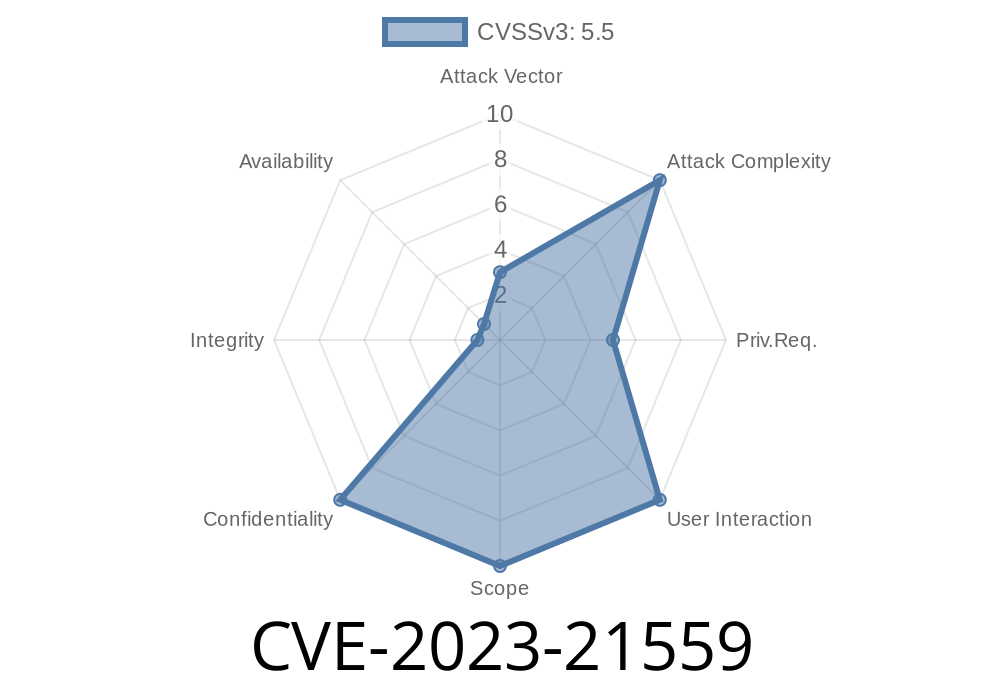Enhancing security for our operating systems is a continuous process, as hackers tirelessly uncover new vulnerabilities. However, knowledge of these vulnerabilities is our greatest defense. As a follow-up to two closely related vulnerabilities (CVE-2023-21540, CVE-2023-21550), let's dive into CVE-2023-21559, a Windows Cryptographic Information Disclosure Vulnerability. We will review in detail the code snippets responsible for the vulnerability, references to this issue, and information about its exploits.
Background
CVE-2023-21559 is an information disclosure vulnerability related to Windows Cryptography functions. A malicious attacker could exploit the vulnerability by analyzing the system's memory and uncovering sensitive information, such as cryptographic keys or users' authentication credentials. The existence of this vulnerability puts users and organizations at risk of unauthorized access, data theft, and other issues.
Code Snippet
To illustrate the vulnerability, consider this code snippet from the Windows Cryptography API (CryptoAPI):
#include <Windows.h>
#include <wincrypt.h>
// ...
CryptAcquireContext(&hCryptProv, NULL, NULL, PROV_RSA_AES, ); // Acquire a cryptographic context
CryptCreateHash(hCryptProv, CALG_SHA_256, , , &hHash); // Create a hash object for SHA-256 algorithm
CryptHashData(hHash, pbData, dwDataLen, ); // Hash the input data
CryptGetHashParam(hHash, HP_HASHVAL, pbHash, &dwHashLen, ); // Get the hash value
// ...
CryptDestroyHash(hHash); // Destroy the hash object
CryptReleaseContext(hCryptProv, ); // Release the cryptographic context
Malicious code exploiting the vulnerability can access the memory allocated for cryptographic operations during the execution of these Windows CryptoAPI functions. If the attacker is successful, they can extract sensitive information such as hashed passwords, cryptographic keys, and other secret data.
Exploit Details
The exploit used to target this vulnerability can be as simple as a malicious script or application that scans the targeted system's memory while the vulnerable cryptographic operations are taking place. However, in reality, more sophisticated attacks are designed to accomplish this goal, taking advantage of multiple vulnerabilities and giving the attacker as much access as possible.
To fully understand the extent and implication of CVE-2023-21559, refer to these official sources
1. National Vulnerability Database (NVD) - CVE-2023-21559
2. Microsoft Security Response Center (MSRC) - CVE-2023-21559
3. Common Vulnerabilities and Exposures (CVE) - CVE-2023-21559
These references provide details, impact scores, and other necessary information used to assist in mitigating the vulnerability.
Conduct regular security assessments and vulnerability scans.
3. If necessary, implement further security controls, such as Data Execution Prevention (DEP), Address Space Layout Randomization (ASLR), or other methods to limit the attacker's ability to analyze memory and extract sensitive information.
Conclusion
CVE-2023-21559 is a concerning Windows Cryptographic Information Disclosure vulnerability, separate from its sibling vulnerabilities (CVE-2023-21540, CVE-2023-21550). It is essential to understand and apply suitable protection measures against these types of vulnerabilities. Stay vigilant in applying security patches, monitoring for new threats, and maintaining the overall security of your systems. Knowledge of vulnerabilities like this is a powerful weapon against the relentless efforts of hackers.
Timeline
Published on: 01/10/2023 22:15:00 UTC
Last modified on: 01/17/2023 18:01:00 UTC
